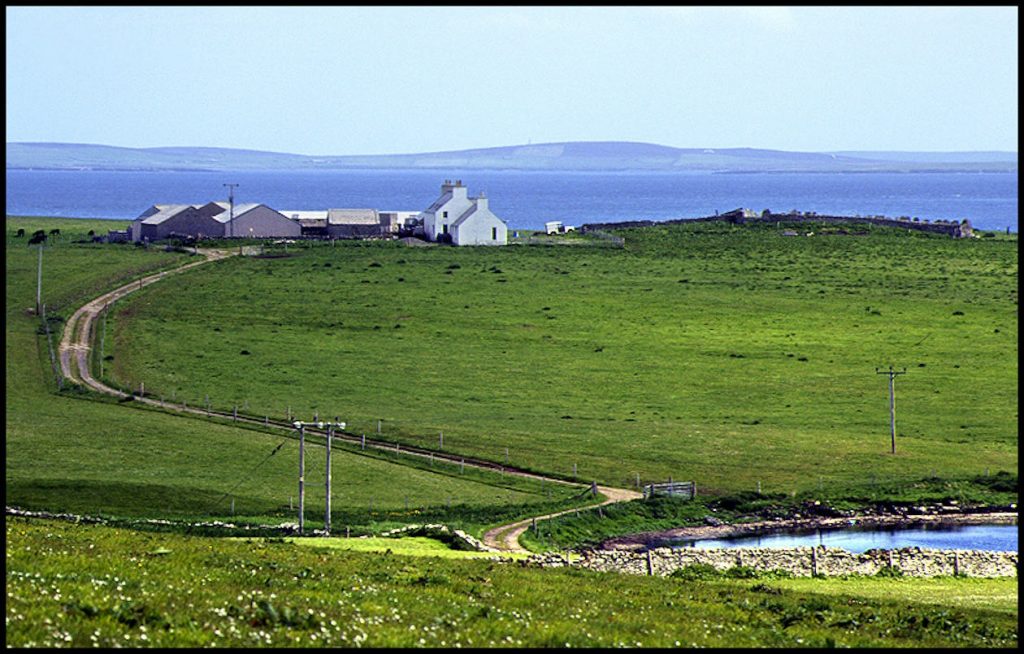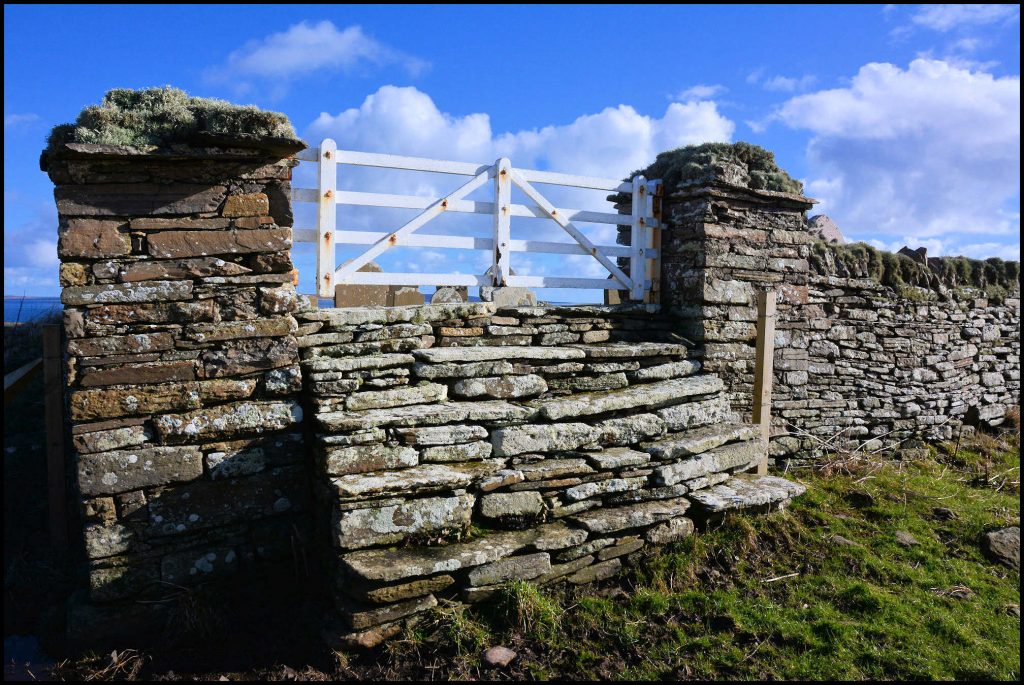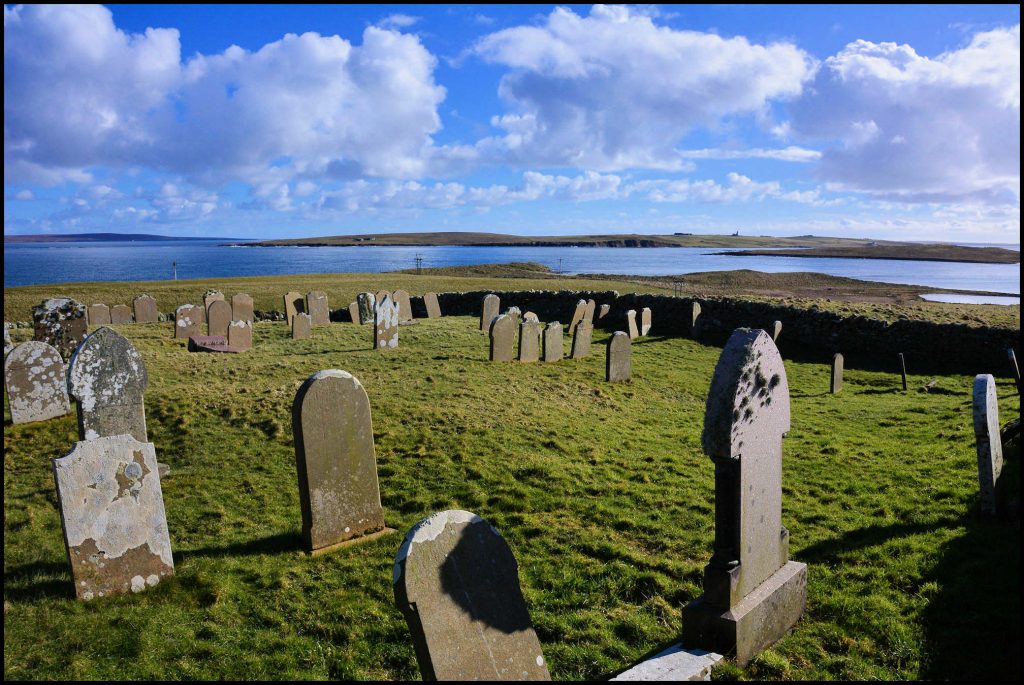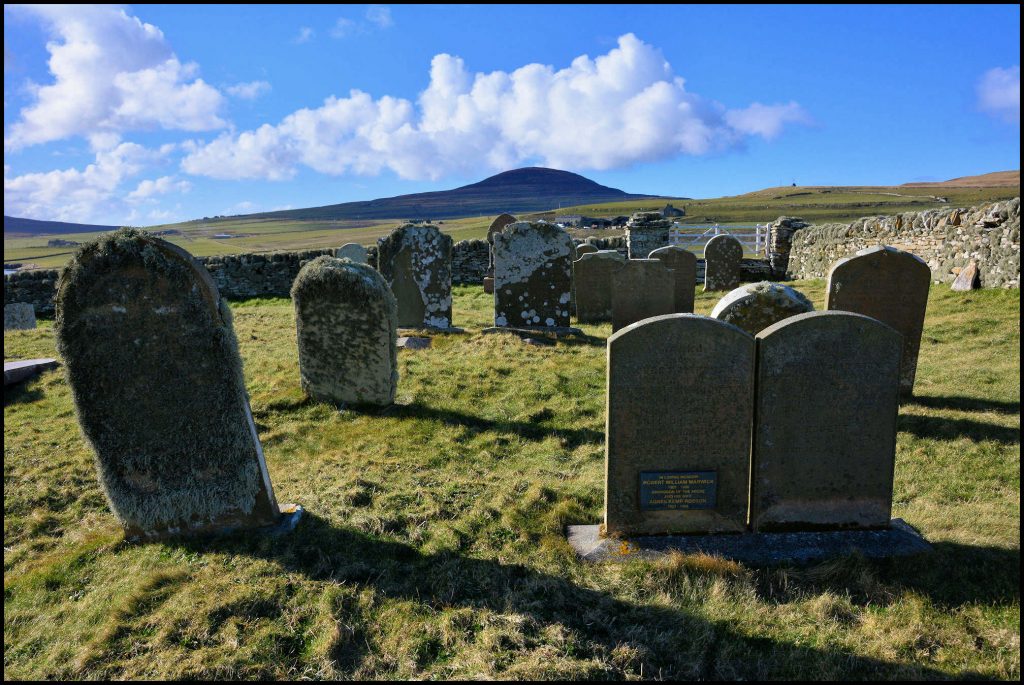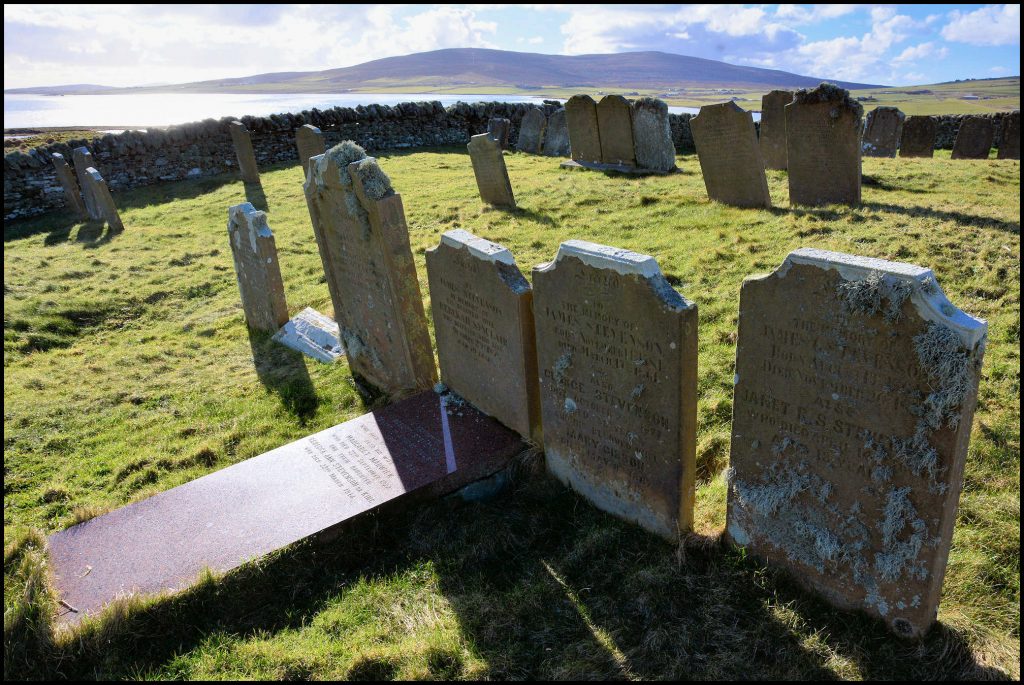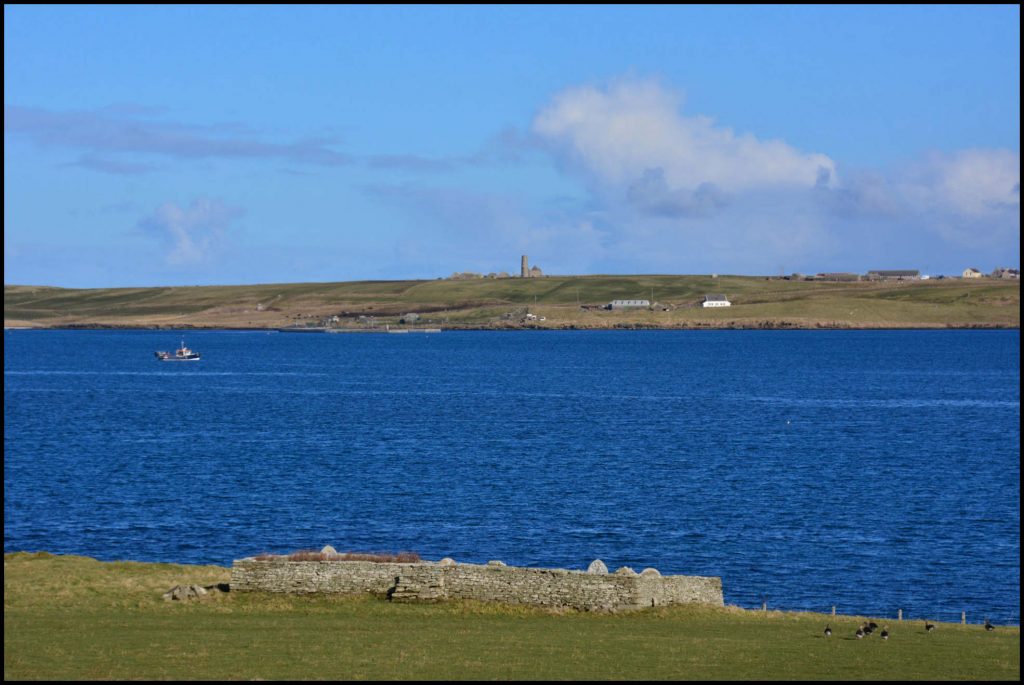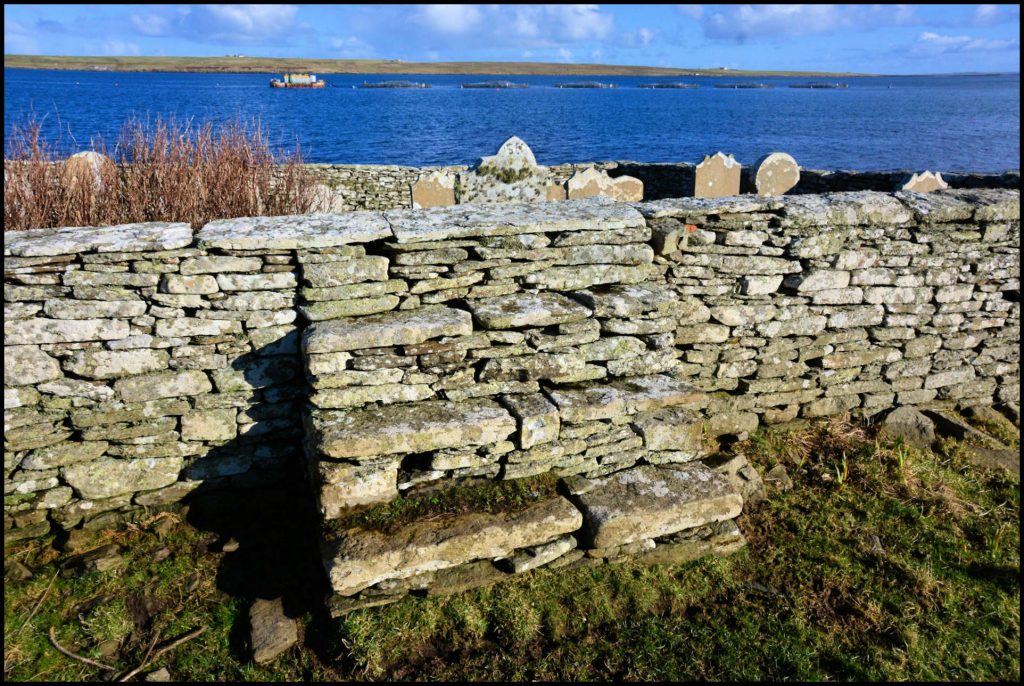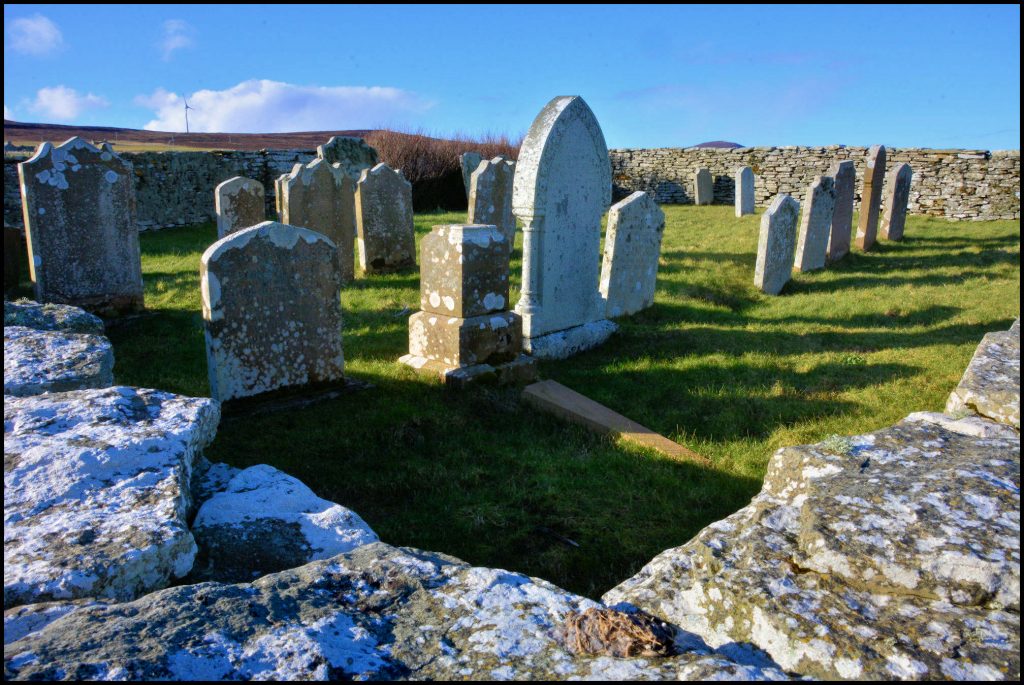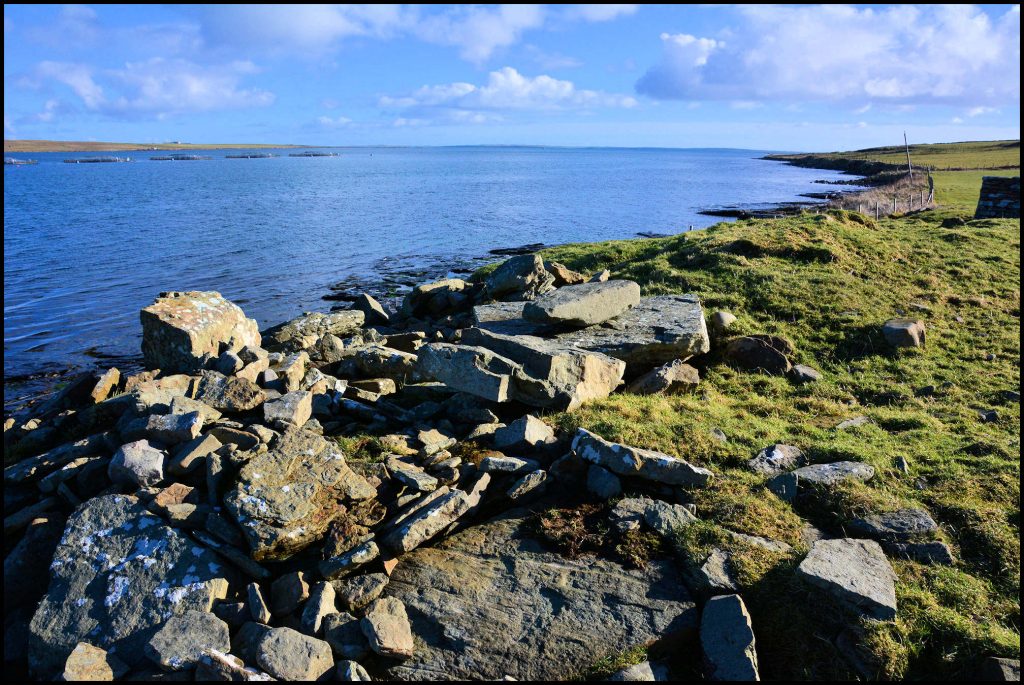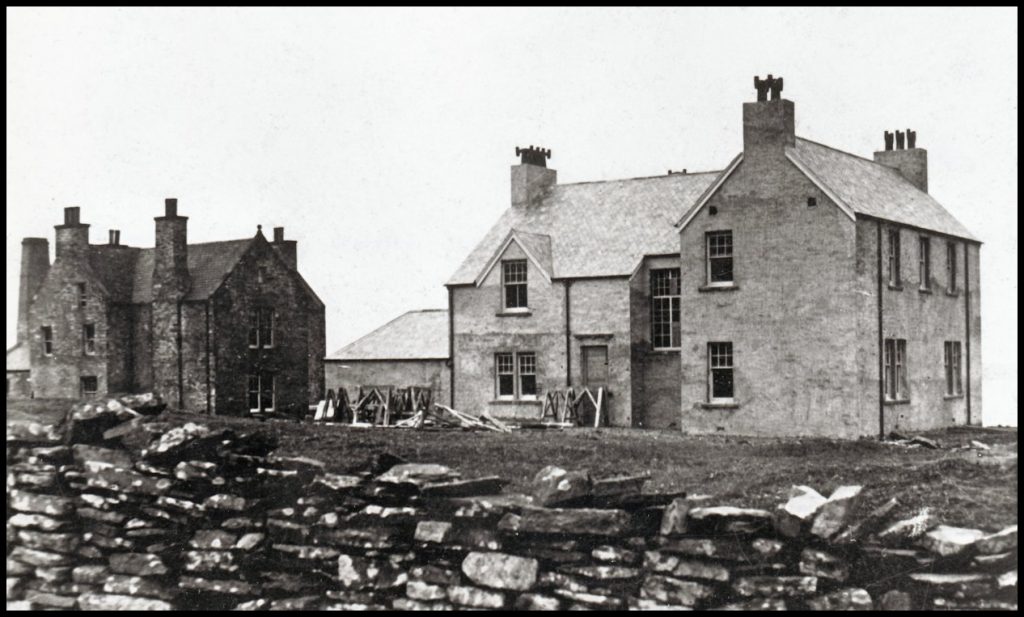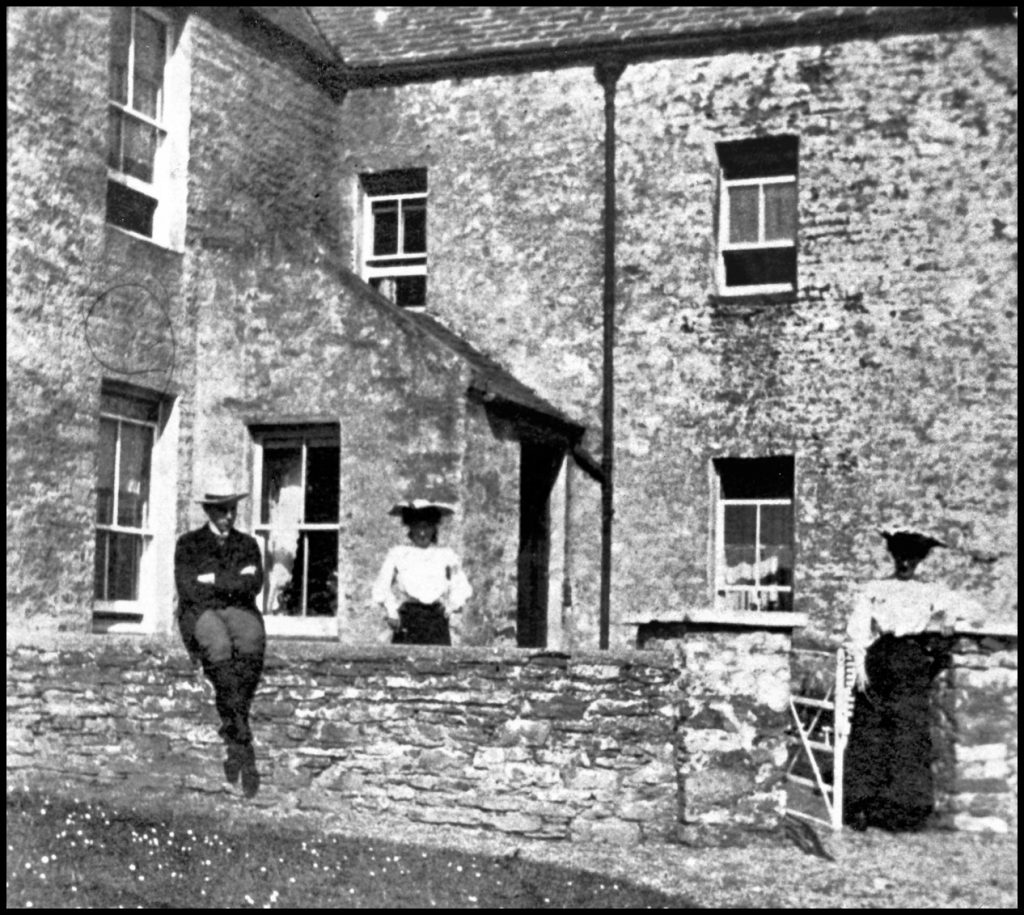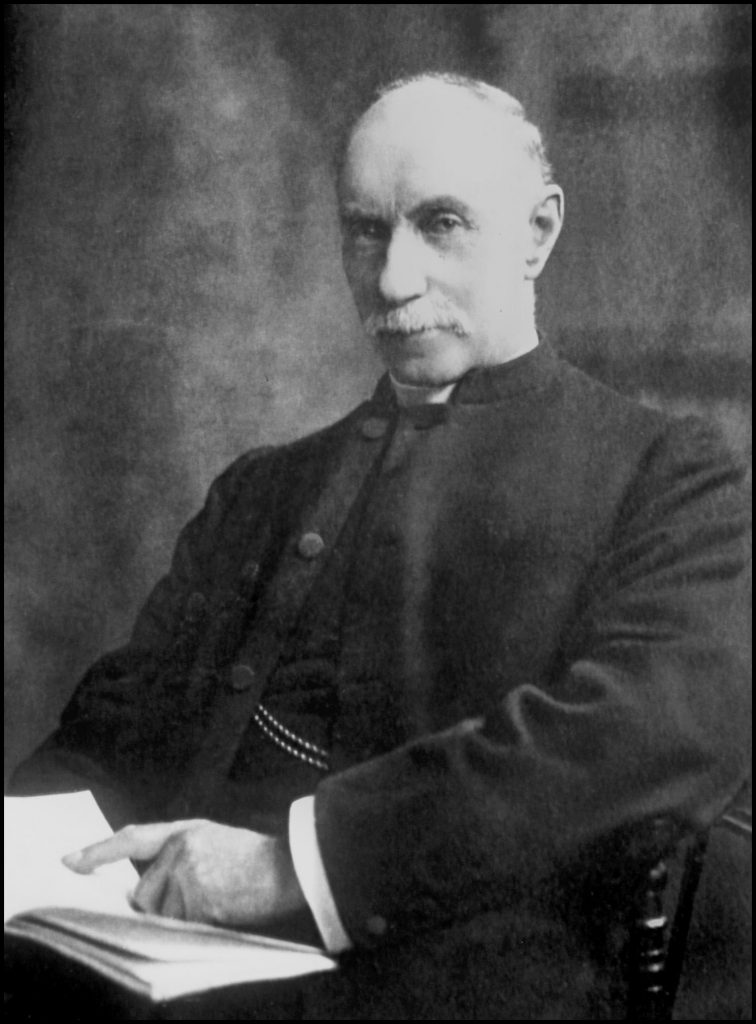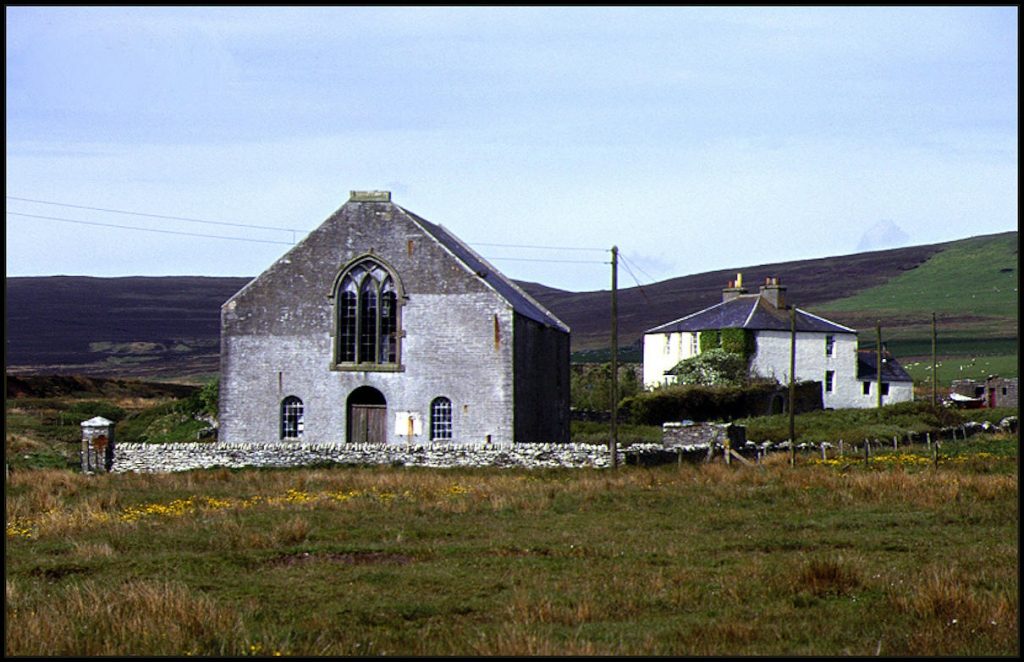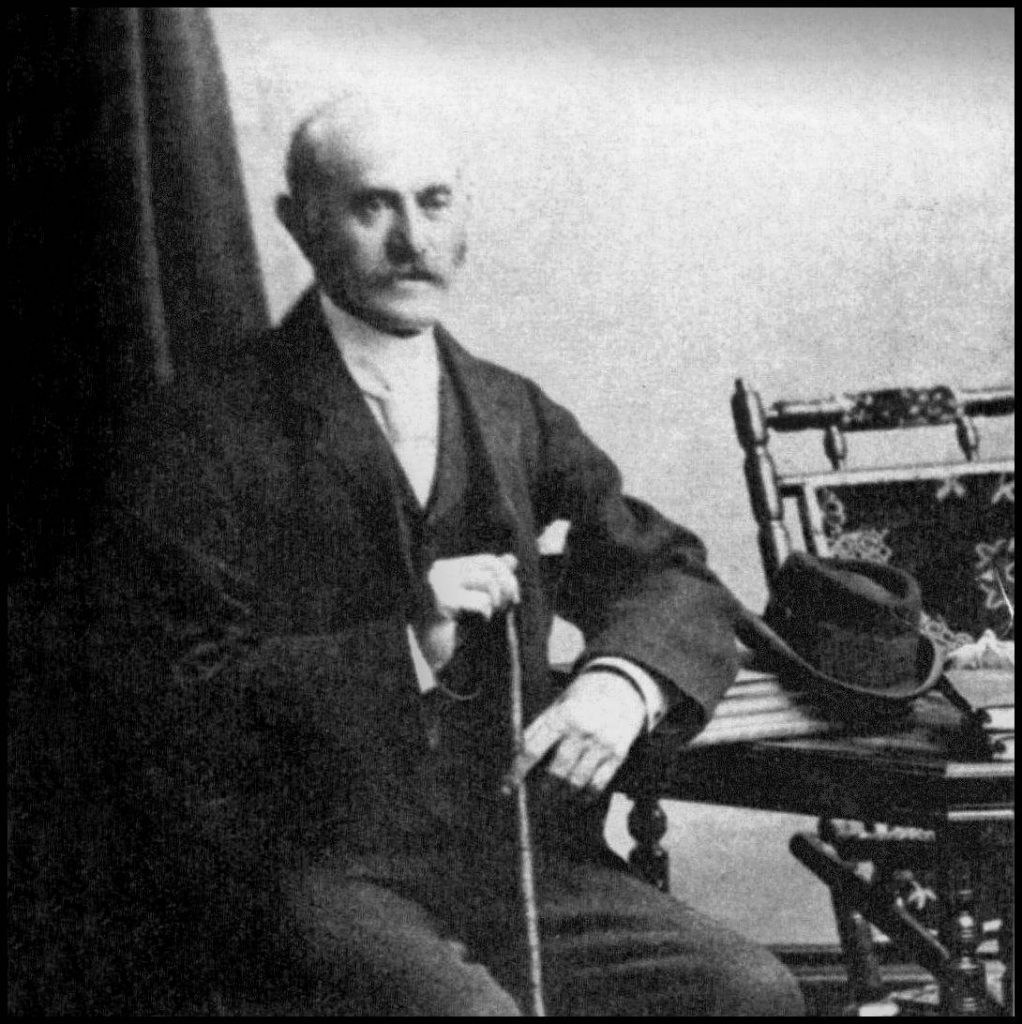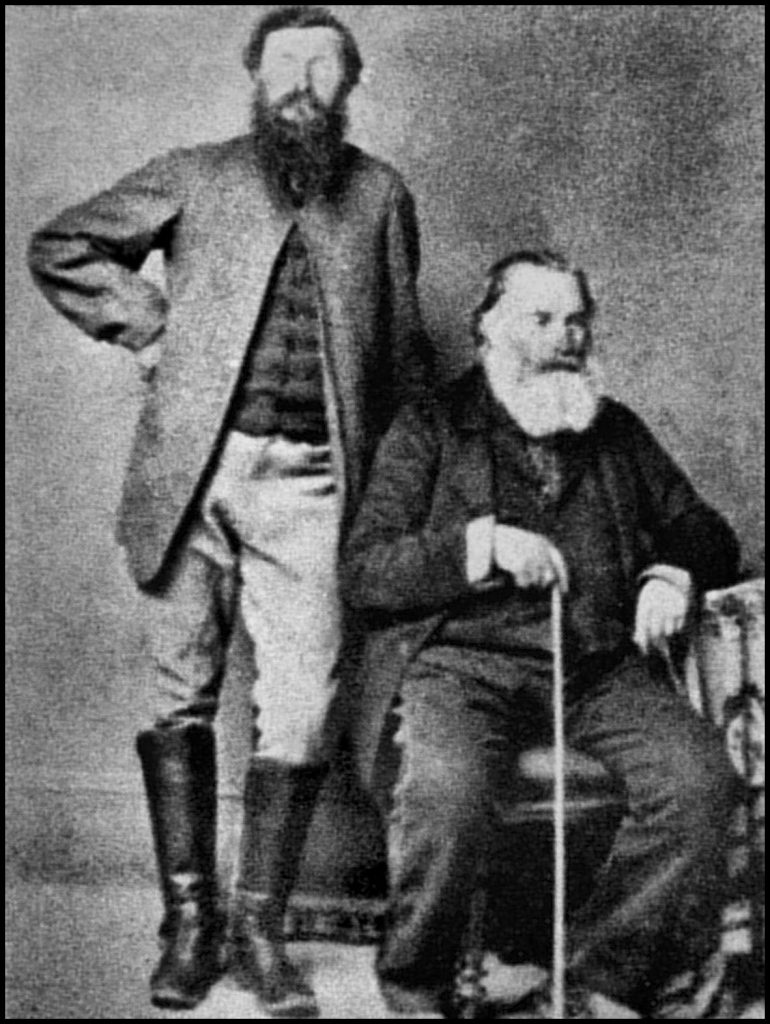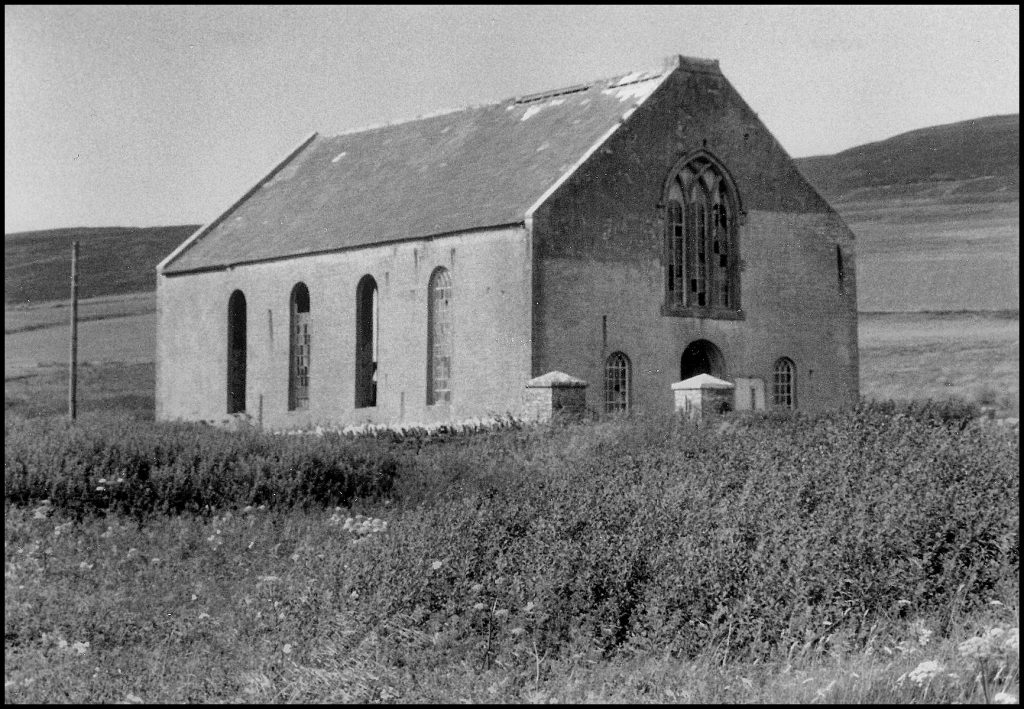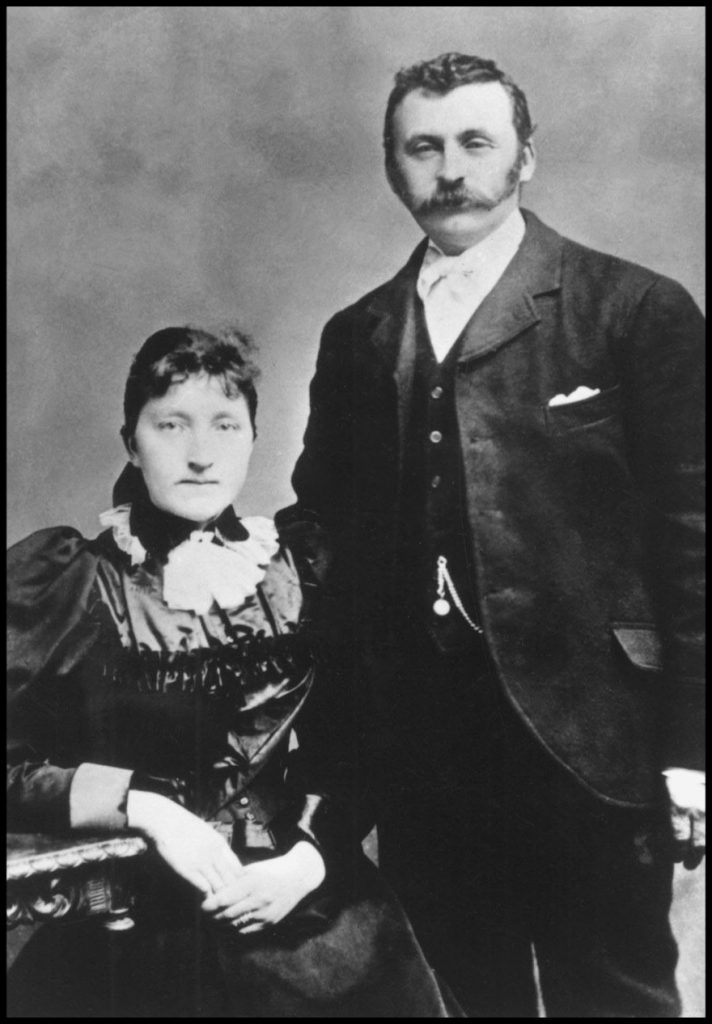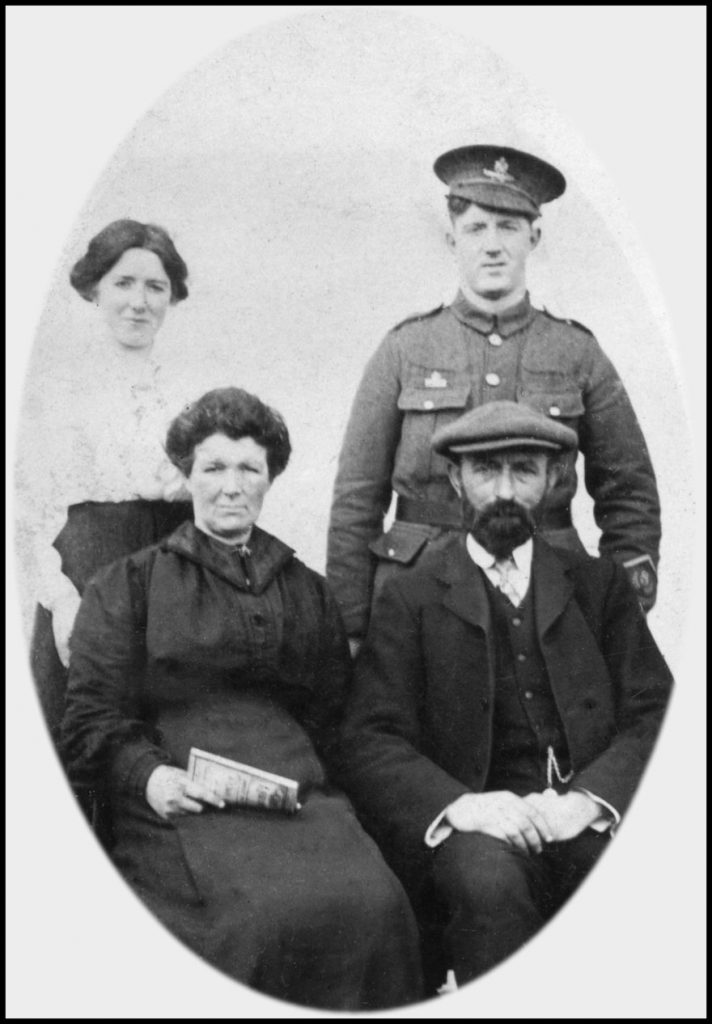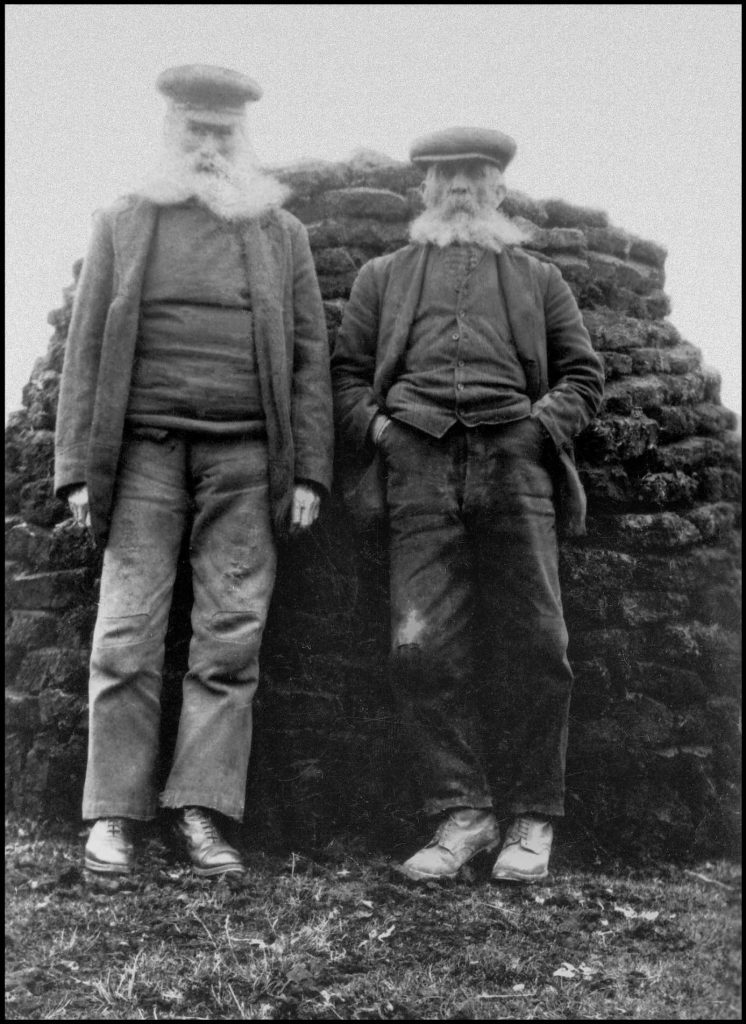The Kirks and Kirkyards of Rousay, Egilshay and Veira – Part 2
by
Tommy Gibson
At Scockness the Kirkyard was built on the highest point of land on the farm. The dyke built around the yard looks to be a very old construction. It measures 28 yards north and south and by 30 yards east and west. This was closed in the 1930s but the last interment was in 1958. There are a total of 68 headstones, including three that have fallen. The wall around the yard is in good condition but the north wall seems to be a lot older and starting to lean out. There would have been a Kirk there at one time.
This may have been in the 17th century, although, there is no evidence of a foundation for a building but on old maps a Chapel is mentioned, this was to the west of the kirkyard. At Scockness, like the other old Kirkyards the ground inside the dyke is a lot higher than outside. At the east side the ground is about 3 ft higher than the ground on the outside of the Kirkyard. I wonder if it is because of the sheer volume of interments. Even if the kirkyard had only been there since the l7th-century there must have been untold hundreds of interments in the old kirkyards. In Sourin the population for 1841 was 327.
When the last gravedigger for the Scockness kirkyard dug a grave he always had a lot of bones to hide till the funeral was over. The bones were always returned but there was supposed to be a pile of skulls thrown in the lower corner by previous diggers. He would go into Scockness for his dinner but he never washed his hands. It never hurt him; he died in 1938 when he was 98. At the north side of the Kirkyard was the old Tollbooth or prison. This was a square stone building covered with earth and grass. A very small window looked across to Eday, also with a small entrance. If anyone, for any reason, was cast into this prison let’s hope it was in the summer time. The wintertime must have been very cold. This was removed in the early sixties when a new steading was built on the farm.
The Chapel below the Glebe at the shore in Sourin is the smallest of all the Kirkyards, with only 30 headstones. Its size is only 45ft x 36ft. Traditionally it was supposed to have the most interments for its size. Is this the oldest Kirkyard?
The dyke around the yard is in fair condition. The corners of the wall are in need of repair. The last internment was in 1943. At The north side of the yard is a mound with suggestions of a foundation, was this the site of a Kirk or Chapel? In the field above to the south west there is a large foundation. This was even an earlier Kirk, long gone. Again legend has it that a Kirk had been built in front of Knarston, which is nearby. This Kirk again, is long gone. Knarston is a very old farm with records going back to c1400.
Near the Glebe is one of the three Manses. This manse is for the Established Church. This one was built about 1908-9. In 1906 the membership for the Old Kirk was 71, and the minister, the Rev. Alexander Spark received a stipend of £184. This money had a purchasing power of £9542.24p (1996 figures). The average farm worker earned about £16 per year. Purchasing power was £830.
The Rev. Spark took a dislike to the old Manse, and about 1900 tried to get his congregation to build a new one for him. He took up a building surveyor from Edinburgh to examine the manse, claiming that the walls were damp. The Rev. took buckets of water to dampen the walls, just to make sure. He also wrote to General Burroughs, the laird who owned the parish, demanding the use of a house “worthy of my status, such as Westness House” while the manse was being built. He went to live in Kirkwall while the new manse was being built. The contract was awarded to Samuel Firth, building contractor, Harray, Orkney. The manse was completed in 1909 at a cost of approximately £900. The old manse was probably built about 1747-50: this would have made the building about 160 years old. It is a pity that a date stone from the old manse was not preserved.
John Corsie, who was a servant man at The Glebe, was carting peats to Mrs. Spark, at the Manse. Mrs. Spark said to one of the servant girls to put a cake on a tray and cut a slice and offered it to the hungry John. John, with a mischievous grin took the cake and left the slice! “Ma’am”, the girl shouted to Mrs. Spark, “he took the wrong piece, what will I do”? The Rev Williams was the last minister in the Established Kirk. Unfortunately not much is known about him except that he had a rather arrogant nature. Now the West Manse is the Church and Day Centre, opened on August 27th 1995. Two rooms on the ground floor were made into one, and made a sizeable hall. This is used every Wednesday for the Triangle Club for the old folks and not so old ones, and at weekends used for services and meetings.
In Sourin to the West of the crossroad is the Free Kirk. This was said to be a low narrow thatched building. It was rebuilt around about the late 1840’s. The story was, (I have never seen any records) that the Kirk was lengthened, heightened and widened. The quarrying, masonry and labouring work was done freely by the Sourin folk. The stones came out of a small quarry nearby. The Reids of Wasdale (a farm near the Kirk) were said to be in charge of the joinery, for there was a tremendous amount of work in the roof. The roof trusses were only 18 inches centres. The window frames were a little too short so they scared (scarfed) a new bottom on to the frame of the window. This was still there a few years ago. In fact the top of the window was in a better state than the bottom. While this building was going on, the services were held in the open air. I have heard that this took place at Knarston and also I believe near to the Sourin Kirk.
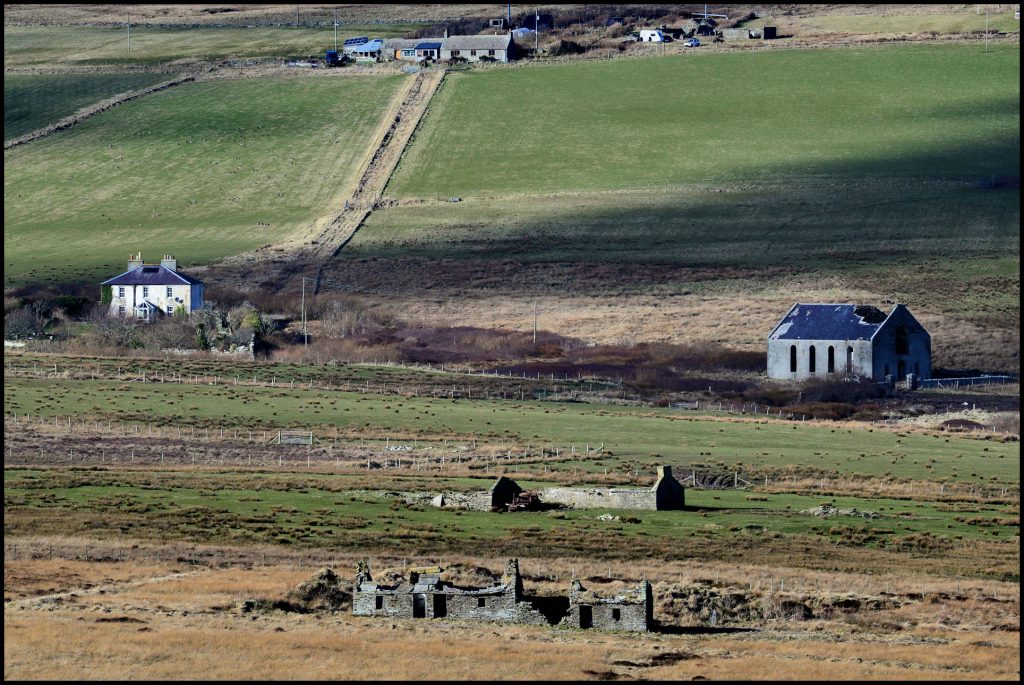
It was known as the Ritchie Church. The Rev. George Ritchie was born in Glasgow in 1789. He came to Rousay to the Established Church in 1837 remaining in Rousay till his death on the 23rd Oct. 1858. At the disruption in 1843, he was one of six ministers who ‘came out’, in Orkney, bringing the greater part of the new congregation to the new Free Church in Sourin. He was married to Isabella Anderson on the 6th October 1840. They are both buried at Scockness. The Free Kirk was one of the few Organizations that recognized over population in the Isles. It used to help to pay the young folk to go to the colonies. Most of them had nothing and they went to nothing. Many of them made good. The Free Kirk, like others, also benefited from legacies. On the 28th day of June 1892, The Rev. Bonellie received £157 15s 1d from the late Thomas Mainland, a fisherman\farmer of Springfield. This would have been a considerable boost to the funds.
Above right, is Thomas Marwick [seated], with his son-in-law Richard Craigie in New Zealand. Richard married Thomas’s daughter Mary in 1859, but she died in 1862. That same year he then married Mary’s sister Isabella, and they went on to have a family of ten children, four boys and six girls. – [Photo courtesy of Janet Craigie-McConnell, NZ]
Not many records exist of the Sourin Kirk but I would like to mention one elder, Thomas Marwick of Woo. Thomas was born at Scockness in 1796, and married Ann Gibson of Broland in 1820, was a farmer for a short while at Banks, Sourin then Woo. They had 10 of a family; most of them went to New Zealand and Australia. His wife died in 1861 so Thomas went out to New Zealand with his daughters Mary and Isabella in 1857. Thomas was an elder in the Free Kirk and he was given a presentation when he left Rousay. Another elder and presentor was James Leonard of Digro. James was a deeply religious man. After giving evidence to the Crofters Commission against the Laird, General Burroughs, he was evicted from Digro. James went to Kirkwall for a short while then he went to Oban, and was active in the Kirk there. He never returned to Rousay.
In 1873 the School (this is now the Old School) was too small so all the bairns went to the Kirk to be used for a school. There were more than 80 pupils going to the school. In the Old School the classroom was only a small room. It must have been cramped conditions, and then going into a huge room of the Kirk must have been bliss. The Sourin folk were very loyal to their Kirk; nearly every household in Sourin went to the Free Kirk. Only seven families from Sourin went to the U.P. Kirk, and these were mainly families that came into Sourin from Wasbister and Frotoft, this was between 1875 and 1906. It is not known how many went to the Established Kirk. I was told that when Christina Craigie of Fa’doon was “cried in the Kirk” (the Banns) every seat was taken and the balcony was full, they were sitting in the windowsills and even standing in the aisles. There were only two folk in Sourin who were not at this event and the rest of the folk thought they were “queer”.

One person I must specially mention is James William Grieve, of White Ha. Known to all as Cheemie-Willie. A quiet kindly man liked by all. He was a faithful office-bearer over 40 years. He became an Elder on the 30th July 1899 before his 24th birthday and served till he left Rousay in 1942 to live with his daughter in Birsay. He was very, very musical and held various certificates. Weddings and most dances saw James William playing the fiddle, usually on his own. There was no amplification in those days. Mr. Grieve died on the 17th March 1951 aged 75 and is buried in the Brinian Kirkyard. Along with J.W. Grieve that day in 1899 was Mr. Hugh Craigie of Swandale was also ordained an Elder. Mr James Clouston of Tou, d. 1945, was ordained a Deacon along with Hugh Craigie of Deithe, d. 1933, and John Gibson of Broland, my grandfather, and he died in 1934. A deacon is an officer of the church and the duties are looking after the finance and the running of the Kirk.
James William Grieve, Whiteha’,
with his wife Mary Ann Harrold
and visitor Jean Hackston. c.1930.
The other four men elected as Deacons that day in 1899:
Above left is Hugh Craigie, Swandale, with his wife Lizzie. Above right is James Clouston, Tou, with wife Annabella and children Clara & Jim.
On the right in the picture below left is John Gibson, Broland, with Malcolm Leonard, Quoys. Below right is Hugh Craigie, Deithe, with his wife Maggie.
Evenings in the Sourin Kirk were something to behold. Kirk Socials and Soirees were always outstanding successes. The performances would make any opera company of today envious. Not one seat was empty. Organising concerts in the Kirk must have been a massive undertaking. One programme had 28 items. Songs, part songs, duets, selections, quartets, choir singing, were all part of the programme. This was the work of William Grieve of Fa’doon. He was a cousin of James William, and also a gifted musician and teacher. William was also presenter in the Sourin Kirk. His son Robert took over as the presenter in 1934 till he left to go and live Sandwick in November 1960. Robert, a blacksmith, was also a gifted musician and singer. All that family were musical and they “understood” music. I remember the first time I was in the Sourin Kirk in the Broland seat, every house had a seat, the rent of this seat used to be 2/6, (12½ pence per year) at the back wall. We went into the Kirk about 20 past 11, must not be late. At half past 11, the Rev Davidson was led in to the pulpit by an elder. He sat in the pulpit what seemed to me as an eternity then he rose from his seat and there was a prayer. Then a hymn was announced. A huge man stood up in front of the pulpit, this was Robert Grieve, the organ sprang into life, this man started to bellow and sing. I thought this man had gone crazy, making such a noise. I was never so frightened in my short life [I was only 4 years old] and was wishing that the ground would open and swallow me up. Soon the music finished, time for a pandrop (a strong peppermint sweetie). Soon the minister was at the sermon; every now and then a fist was hammered on the pulpit to emphasize a point, which made every one jump. No one sleeps through my sermons!
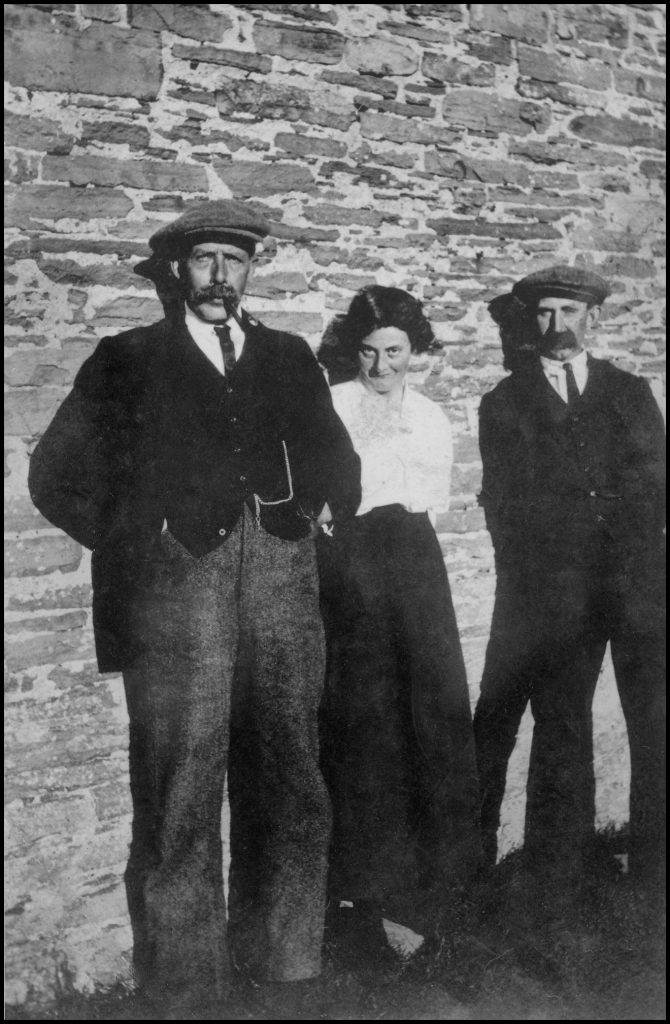
One more point I must make; the music in the Rousay kirks was sung at slightly faster speed than a lot of parishes in Orkney. The parish of Birsay was the same. Singers from other parishes, visiting Rousay Kirks, said that it was most refreshing to listen to hymns and psalms sung at a faster, or the correct speed. At the end of April 1967, a meeting was held in the Sourin Kirk about closing down. The voting was 16 for closing and 4 against. It was Mr. Hunter who was the missionary in Rousay at the time. Wilma Mainland, (Mrs. Fraser) of Essaquoy was the last person to get married here in 1969. It was opened especially for this event. I remember the light came from Tilley lamps. This Kirk had its own manse, which was rebuilt around about the same time as the Kirk, this is now known as Burnside.
Cruannie blacksmith Robert Grieve, with
Ann and Wille Grieve of Digro on the right
I can remember on a Sunday in the early 1950’s, the folk leaving the Kirk at 12:30 and walking home. Every one walked to and from the Kirk in those days. They had reached the crossroads and were still coming out of the Kirk. Not many cars in these days, but two cars were usually there. The first one belonged to Rev. Davidson, and the other was from Trumland House, usually driven by David Pirie, the gardener. The Rev. Davidson took his car, a Morris Cowley, to the smithy at Cruannie. “Mr. Grieve,” said the Rev. Davidson, “there is a strange sound coming from my car! Will you walk along side and try to locate the noise.” “Fine hid” said Mr. Grieve. The minister started the car and Robert walked along side, “Can you hear anything, Mr Grieve?” “Lord, I can’t hear a thing,” Robert replied. “Do not take the name of The Lord in vain,” said the minister. To this Robert replied, “Good, I was Not taking His name in vain, I have never taken His name in vain in all me life”.
On the 2nd of February 1952 a violent hurricane hit Britain, and was particularly hard on the North of Scotland. I hope the like never returns again. I remember the morning of the hurricane, the old Hall was destroyed and a lot of damage was done to the school. Stacks and hen houses were also blown down. Thousands of hens were lost and destroyed. All the telephone poles in the parish were either at a list or blown down. By co-incidence a GPO lorry and a gang of men were working in Rousay. The men were staying in the manse, (Burnside) and the lorry was parked in front of the Kirk. Through the night a huge gust of wind shoved the lorry forward about 20 ft. Then a bigger gust blew down the bell tower right where the lorry was first standing. The men were sorry that the lorry had moved. It was (the bell tower) never replaced. The Sourin Kirk was closed in the early 1960’s and is now in a sad state of disrepair. When the Kirk was closed, the Church of Scotland owned it, and then in the 1970’s it was sold privately.
